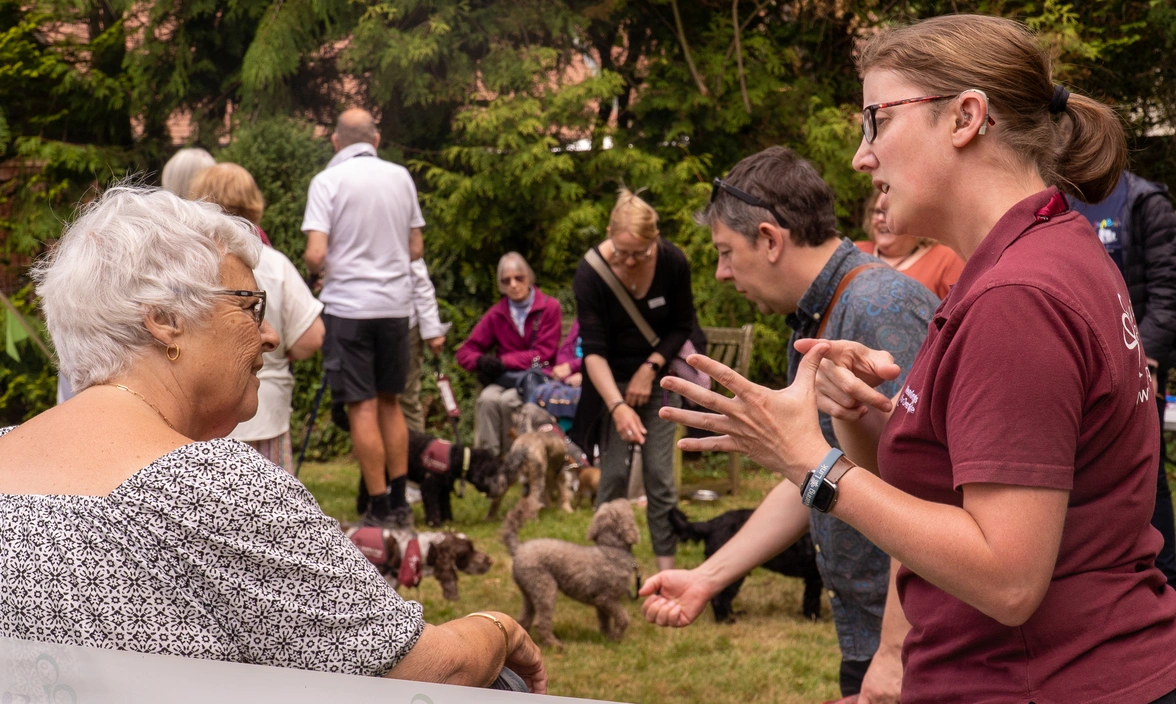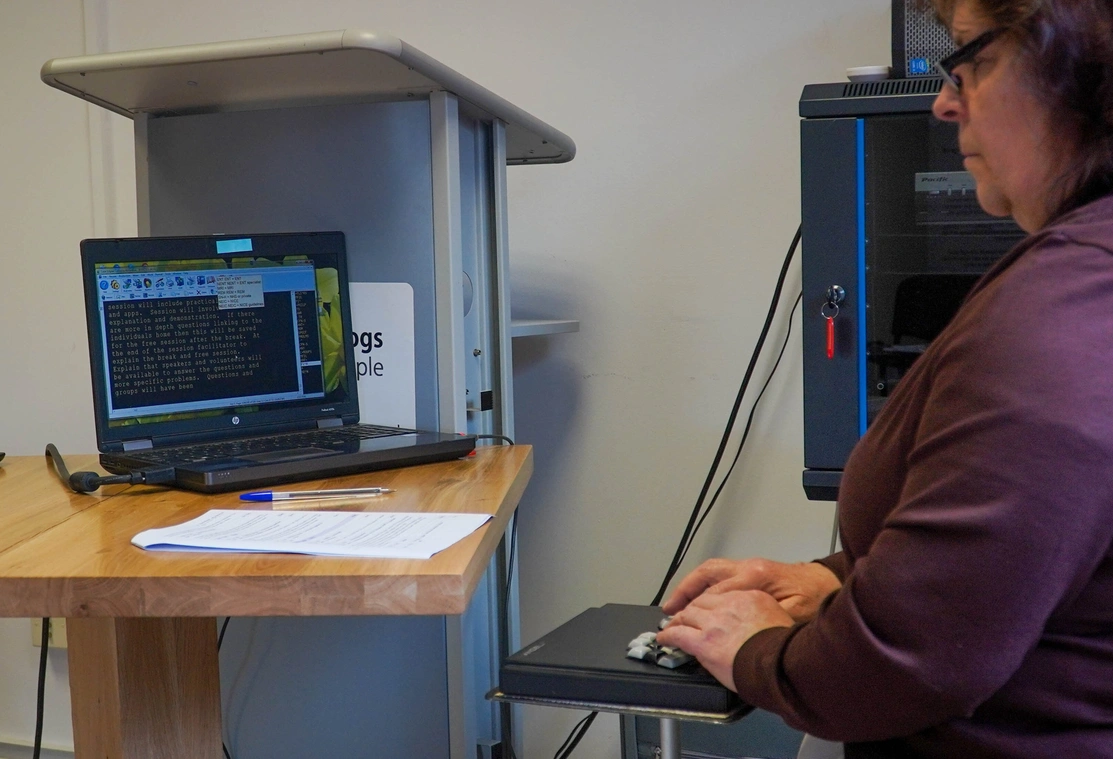Communication support
Communication support is provided by Communication Professionals (or Language Service Professionals). They are for people who are d/Deaf, have hearing loss or are Deafblind.
Communication support is provided by Communication Professionals (or Language Service Professionals). They are for people who are d/Deaf, have hearing loss or are Deafblind.

These professionals play a vital role in helping individuals with hearing or communication difficulties to access everyday situations, such as work meetings, job interviews, or GP consultations.
They provide tailored support, including British Sign Language (BSL), speech-to-text reporting, or other communication methods to facilitate clear understanding between the individual and those around them.
There are several types of Communication Support Workers, each specialising in different methods of communication depending on the needs of the individual. Here are some examples:
Also known as Palantypists or Stenographers, a Speech to Text Reporter (STTR) uses a special phonetic keyboard linked to a laptop computer to relay conversations verbatim.
They transform the spoken word into writing and display what is being said on a computer screen or a large screen at the front of the meeting or on a laptop or smart device.
The STTR works at speed and so the odd imperfection will creep in, but in essence accounts for every word spoken. They will also include any relevant sounds e.g. laughter, door opening.
You may require more than one STTR per event depending on the event duration to allow for eye and listening breaks. In more recent times, technology has advanced so STTR can also be carried out remotely via video calling.

STTRs are regulated by the National Registers of Communication Professionals working with Deaf and Deafblind People. Visit their website for more details or visit the Association of Speech-to-Text Reporters website.
Manual notetakers hand write in English a summary of all relevant spoken information in a wide variety of settings. These include, but are not limited to, classrooms or lecture theatres, meetings, medical appointments, work trainings and conferences.
Having a manual notetaker can leave people with hearing loss free to concentrate on what is being said and allows them to refer to the information that is written down either in the moment or later. Unlike Speech-to-Text Reporters, they do not provide a verbatim account of what is being said, only a summary.
For more information about Manual Notetakers, visit the Association of Notetaking Professionals website.
Electronic notetakers do the same thing a manual notetaker does, but they use a laptop computer. They can often type faster than someone can write using a pen and sometimes the typed version is easier to read than handwriting.
Though electronic notetakers do not provide a verbatim record, they do use special notetaking software that helps speed up the typing process.
Many times, electronic notetakers have two laptops: one that they type on and a second which is connected to the first. This allows the person with hearing loss to read from it. In some settings, they can also project what they are typing onto a screen at the front of the room.
When compared to speech-to-text reporting, electronic notetaking has been described providing ‘all of the meaning, but not all of the words’. This can make it more manageable – and more cost effective – and the digestible notes can be provided to the client after the event.
For more information on electronic note-takers visit the Association of Notetaking Professionals website.
A Lipspeaker is a hearing person trained to repeat a speaker’s message to lipreaders accurately, without using their voice. They produce clearly the shape of words, the flow, rhythm, and phrasing of natural speech and repeat the stress as used by the speaker.
The Lipspeaker also uses facial expression, natural gesture, and fingerspelling (if requested) to aid the lipreader’s understanding. A Lipspeaker may be asked to use their voice, using clear communication techniques, thus enabling the lipreader to benefit from any residual hearing.
Lipspeakers are used in a wide variety of settings by people who use lipreading as their main method of communicating with others.
For more information about lipspeaking, visit the Association of Lipspeakers website.
Sign language interpreters interpret between people who are d/Deaf and use sign language and those who use spoken words.
In the UK, British Sign Language (BSL) is used – and therefore BSL interpreters will interpret between BSL and English. (In Northern Ireland, interpreters will use a combination of BSL and Irish Sign Language.)
The BSL interpreter will speak what is signed, and sign what is spoken, to allow full communication between two or more parties. As with the other Language Service Professionals, BSL interpreters can be used in a wide variety of settings, from educational settings to legal settings to medical settings.
For further information about British Sign Language or to find qualified interpreters in your local area, the following websites may be helpful:
Scottish Collaborative of Sign Language Interpreters website
When someone has both hearing loss and sight loss, or a dual sensory impairment, they may require the services of a Deafblind Interpreter.
These Communication professionals use the Deafblind manual alphabet to relay a conversation onto the Deafblind person’s hand.
Depending on the needs and skills of the deafblind person, Deafblind interpreters may also use the block alphabet or hands-on signing for the personal with the dual sensory loss.
For more information on this kind of communication support, you can visit the RNID website.
Communication Support Workers work in educational settings to support the learning of people with hearing loss. They can work with young people (those under 16) as well as adults (those 16 and older).
They work as part of a team with other professionals like teachers, lecturers, audiologists, etc. to ensure that people with hearing loss have equal access to information and education.
Communication Support Workers may use one or more of the communication strategies described above. For more information about what Communication support workers do, you can read their Codes of Practice.
Look on the National Registers of Communication Professionals website to find a Communication Professional near you.
Many times, the service provider for which you need a Communication Professional will book the service for you if you request it.
However, you can also book a Communication Professional yourself, visit the following websites for further information:
In August 2016, all NHS and adult social care providers across England became legally required to meet NHS England’s Accessible Information Standard.
Its aim is to make sure that all organisations providing NHS or social care make their information accessible for all people in a way they can understand and by providing any communication support they need. This means you should tell your NHS/social care professional:
More information about the Accessible Information Standard in England and Wales, visit the NHS England website.
In 2018, the Scottish Government implemented the “Health and Social Care Standards”. They set out what is expected when using health, social care, or social work services in Scotland.
You can read more about these standards visit the Scottish Government website.
Registered charity in England and Wales no. 293358 and in Scotland no. SC040486. Royal Patron HRH The Princess Royal.